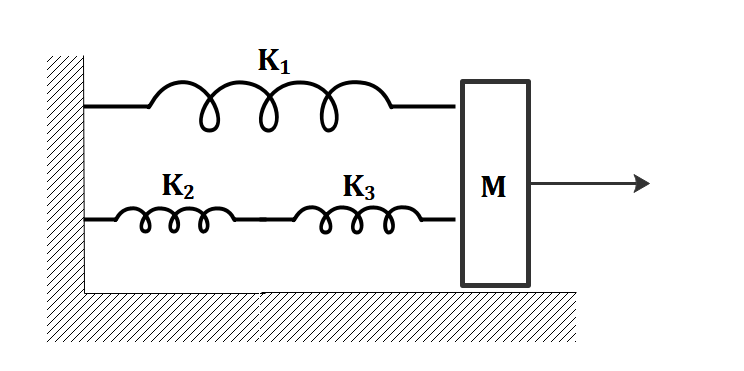
The springs shown in the figure are all unstretched in the beginning when a man starts pulling the block. The man exerts a constant force F on the block. Find the amplitude and the frequency of the motion of the block.


Answer
490.2k+ views
Hint: We are given a spring-mass system where the springs of spring constant
Formula used:
Complete answer:
From the figure given in the question, we can see that the springs with spring constant
Now, both these springs are connected in parallel to the spring with spring constant
So, from this, the three springs can be replaced by a single spring with spring constant Keq.
It is said that a man applies a force F on the mass M. Then the block will start to oscillate in SHM. The amplitude or the maximum displacement is given by
Therefore, the amplitude of the block is
The time period of this SHM is given by
Where,
T is the time period of oscillation;
M is the mass attached to the spring; and
K is the spring constant.
Here, the mass is also given as M and the spring constant will be Keq. Substituting these quantities in the formula, we have
The frequency, say, f of the oscillation will be the reciprocal of the time period, i.e.
Therefore, the frequency of the spring is given by
Note:
If you are either confused or couldn’t remember the equivalent of springs connected in series and parallel, you can simply derive them by remembering small conditions. For any springs connected in series, the total elongation in spring will be the sum of elongation in each spring. For springs in parallel, the elongation will be the same in each spring.
Formula used:
Complete answer:
From the figure given in the question, we can see that the springs with spring constant
Now, both these springs are connected in parallel to the spring with spring constant
So, from this, the three springs can be replaced by a single spring with spring constant Keq.
It is said that a man applies a force F on the mass M. Then the block will start to oscillate in SHM. The amplitude or the maximum displacement is given by
Therefore, the amplitude of the block is
The time period of this SHM is given by
Where,
T is the time period of oscillation;
M is the mass attached to the spring; and
K is the spring constant.
Here, the mass is also given as M and the spring constant will be Keq. Substituting these quantities in the formula, we have
The frequency, say, f of the oscillation will be the reciprocal of the time period, i.e.
Therefore, the frequency of the spring is given by
Note:
If you are either confused or couldn’t remember the equivalent of springs connected in series and parallel, you can simply derive them by remembering small conditions. For any springs connected in series, the total elongation in spring will be the sum of elongation in each spring. For springs in parallel, the elongation will be the same in each spring.
Latest Vedantu courses for you
Grade 11 Science PCM | CBSE | SCHOOL | English
CBSE (2025-26)
School Full course for CBSE students
₹41,848 per year
Recently Updated Pages
Master Class 11 Economics: Engaging Questions & Answers for Success

Master Class 11 Business Studies: Engaging Questions & Answers for Success

Master Class 11 Accountancy: Engaging Questions & Answers for Success

Master Class 11 English: Engaging Questions & Answers for Success

Master Class 11 Computer Science: Engaging Questions & Answers for Success

Master Class 11 Maths: Engaging Questions & Answers for Success

Trending doubts
State and prove Bernoullis theorem class 11 physics CBSE

What are Quantum numbers Explain the quantum number class 11 chemistry CBSE

Write the differences between monocot plants and dicot class 11 biology CBSE

Why is steel more elastic than rubber class 11 physics CBSE

Explain why a There is no atmosphere on the moon b class 11 physics CBSE

1 ton equals to A 100 kg B 1000 kg C 10 kg D 10000 class 11 physics CBSE




